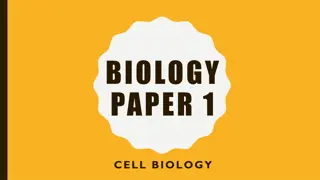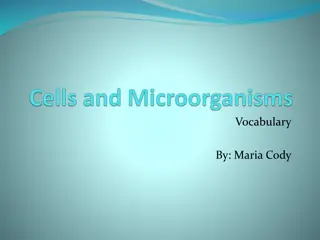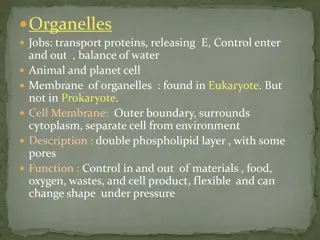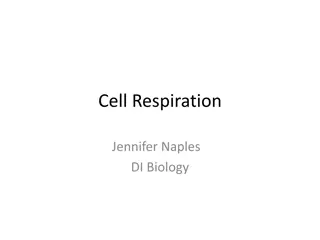Understanding Cell Biology: The Building Blocks of Life
Cell biology, also known as cytology, is the study of the structure, function, molecular organization, growth, reproduction, and genetics of cells. Cells are the basic structural and functional units of life, found in all living organisms except viruses. Explore the general features, shapes, sizes, and internal organization of cells to gain insight into the fascinating world of cell biology.
Download Presentation

Please find below an Image/Link to download the presentation.
The content on the website is provided AS IS for your information and personal use only. It may not be sold, licensed, or shared on other websites without obtaining consent from the author. Download presentation by click this link. If you encounter any issues during the download, it is possible that the publisher has removed the file from their server.
E N D
Presentation Transcript
THE CELL
INTRODUCTION: Cell biology (Cytology) Kytos=hollow vessel or cell The biological science which deals with study of structure, function, molecular organization, growth reproduction and genetics of cell is called cytology/ Cell Biology. Cell is structural and functional unit of life In short study of structure And functions of the cell called cytology Biology is the subject of life and living organisms.
GENERAL ABOUT CELL All organisms from simplest to most complex plants, animals except virus are composed of cells Some organisms like bacteria, protozoan like amoeba consist of single cell The organisms with only one cell in their body unicellular organisms
The organisms having many cells in their body called multicellular organisms Ex. Most of plants and animals. It is estimated that there are 10 million living species on Earth today. Any cellular organism contain only one type of cell, i. e prokaryotic or eukaryotic cell Nucleus was discovered by Brown in 1833 Purkinje (1839) described cell content as protoplasm
COMMON FEATURES OF CELL Each cell-mass of protoplasm Containing cytoplasm with cell organenelles Centrally nucleus (Nucleoplasm) Surrounded by plasma membrane. Definite str. & functional capacities like- Cell division and reproduction Store information in genes made up of DNA
CELL SHAPE AND SIZE All eukaryotic cells generally spherical Shape determine by specific function Variable from cell to cell Shape is fixed but in amoeba, leucocytes, chromophores changing constantly Variable organ to organ Same organ may display various shapes
DIFF. SHAPES OF CELL Flattened; sq. epithelium, endothelium, epidermis Cuboidal-cells of thyroid glands and follicles Columnar - cell lining of intestine Spherical- eggs of many animals Spindle- smooth muscle fibers Discoidal-disc like RBCs Elongated- nerve cells Branched- melanocyte
INTERNAL ORGANIZATION Cells contain a variety of internal structures, called organelles. Def. a cell component that performs specific functions for the cell. The organelles of a cell maintain the life of a cell. All cells are surrounded by a thin membrane called a cell /plasma membrane. Cells have a nucleus, which contains genetic information and directs the activities of the cell.
CELL SIZE Eukaryotic cells are lager than prokaryotes Bact. 0.2- 0.5 micron Egg 15cm (ostrich) RBC 7-8- micron( ) Nerve cell- up to 1 meter Depends on functional state of cell
The cell is one of the most basic units of life. There are millions of different types of cells. The cell is the smallest unit of life in our bodies. In the body, there are brain cells, skin cells, liver cells, stomach cells, and the list goes on.
All of these cells have unique functions and features. And all have some recognizable similarities. All cells have a 'skin', called the plasma membrane, protecting it from the outside environment. The cell membrane regulates the movement of water, nutrients and wastes into and out of the cell. Inside of the cell membrane are the working parts of the cell.
At the center of the cell is the cell nucleus. The cell nucleus contains the cell's DNA, the genetic code that coordinates protein synthesis. In addition to the nucleus, there are many organelles One important cellular organelle is the ribosome. Ribosomes participate in protein synthesis.
Another important cellular organelle is the mitochondrion. Also referred to as the power plants of the cell because many of the reactions that produce energy take place in mitochondria. Also important in the life of a cell are the lysosomes. Lysosomes are organelles that contain enzymes that aid in the digestion of nutrient molecules and other materials.
There are many different types of cells. One major difference in cells occurs between plant cells and animal cells. Many animals have skeletons to give their body structure and support. Plants do not have a skeleton for support. This is because of a unique cellular structure called the cell wall. The cell wall is a rigid structure outside of the cell membrane composed polysaccharide cellulose. mainly of the
In addition to the cell wall, plant cells contain an organelle called the chloroplast. The chloroplast allow plants to harvest energy from sunlight. Specialized pigments in the chloroplast (including the common green pigment chlorophyll) absorb sunlight and use this energy to complete the chemical reaction: 6 CO2+ 6 H2O + energy (from sunlight).> C6H12O6+ 6 O2
WHAT IS A CELL? Cells are the structural and functional units of all living organisms. Some organisms, such as bacteria, are unicellular, consisting of a single cell. Other organisms, such as humans, are multicellular, or have many cells. Each cell is an amazing world unto itself: it can take in nutrients, nutrients into energy, carry out specialized functions, and reproduce as necessary. convert these
BASIC TYPES Eukaryotes- organisms whose cells contain a membrane-bound nucleus and other membrane- bound organelles. Prokaryotes- organisms that do not have a membrane-bound nucleus or membrane-bound organelles.
RED BLOOD CELLS Red blood cells (abbreviated RBCs; also referred to as erythrocytes or simply, as red cells) are the most common type of blood cell and the vertebrate organism's principal means of delivering oxygen (O2) to the body tissues via the blood flow through the circulatory system. They take up oxygen in the lungs or gills and release it while squeezing through the body's capillaries. These cells' cytoplasm is rich in haemoglobin, an iron-containing biomolecule that can bind oxygen and is responsible for the blood's red color.
In humans, mature red blood cells are flexible biconcave disks that lack a cell nucleus and most organelles. 2.4 million new erythrocytes are produced per second. The cells develop in the bone marrow and circulate for about 100 120 days in the body before their components are recycled by macrophages. Each circulation takes about 20 seconds. Approximately a quarter of the cells in the human body are red blood cells
CELL ORGANELIES Within cells there is an intricate network of organelles that all have unique functions. These organelles allow the cell to function properly. Arranged below according to location (nucleus, cytoplasm, and surface) is a description of common organelles Cell wall Centrioles Chloroplasts Chromosomes Cytoskeleton Endoplasmic reticulum Nuclear membrane Nucleolus Golgi apparatus Lysosome Mitochondria Plasma membrane Ribosomes Vacuoles 1. 2.
NUCLEUS: One or more per cell Spherical shape Denser than surrounding cytoplasm Chromosomes - Usually in the form of chromatin - Contains genetic information - Composed of DNA - Thicken for cellular division - Set number per species (i.e. 23 pairs for human)
NUCLEAR MEMBRANE - Surrounds nucleus - Composed of two layers - Numerous openings for nuclear traffic
NUCLEOLUS - Spherical shape - Visible when cell is not dividing - Contains RNA for protein manufacture
CYTOPLASM Collective term for cytosol and organelles contained within Colloidal suspension Cytosol mainly composed of water with free- floating molecules Viscosity constantly changes
Centrioles - Paired cylindrical organelles near nucleus - Composed of nine tubes, each with three tubules - Involved in cellular division - Lie at right angles to each other
Chloroplasts - A plastid usually found in plant cells - Contain green chlorophyll where photosynthesis takes place -------------------------------------------------------------- Cytoskeleton - Composed of microtubules - Supports cell and provides shape - Aids movement of materials in and out of cells
Endoplasmic reticulum: - Tubular network fused to nuclear membrane - Goes through cytoplasm onto cell membrane - Stores, separates, and serves as cell's transport system - Smooth type: lacks ribosomes - Rough type (pictured): ribosomes embedded in surface
GOLGI APPARATUS - Protein 'packaging plant' - A membrane structure found near nucleus - Composed of numerous layers forming a sac
Lysosome - Digestive 'plant' for proteins, lipids, and carbohydrates - Transports undigested material to cell membrane for removal - Vary in shape depending on process being carried out - Cell breaks down if lysosome explodes
Mitochondria: - Second largest organelle with unique genetic structure - Double-layered outer membrane with inner folds called cristae - Energy-producing chemical reactions take place on cristae - Controls level of water and other materials in cell - Recycles and decomposes proteins, fats, and carbohydrates, and forms urea
Ribosomes - Each cell contains thousands - Miniature 'protein factories' - Composes 25% of cell's mass - Stationary type: embedded in rough endoplasmic reticulum - Mobile type: injects proteins directly into cytoplasm Vacuoles - Membrane-bound sacs for storage, digestion, and waste removal - Contains water solution - Contractile vacuoles for water removal (in unicellular organisms)
Cell wall - Most commonly found in plant cells - Controls turgity - Extracellular structure surrounding plasma membrane - Primary cell wall: extremely elastic - Secondary cell wall: forms around primary cell wall after growth is complete
Plasma membrane - Outer membrane of cell that controls cellular traffic - Contains proteins (left, gray) that span through the membrane and allow passage of materials - Proteins are surrounded by a phospholipid bi-layer.































